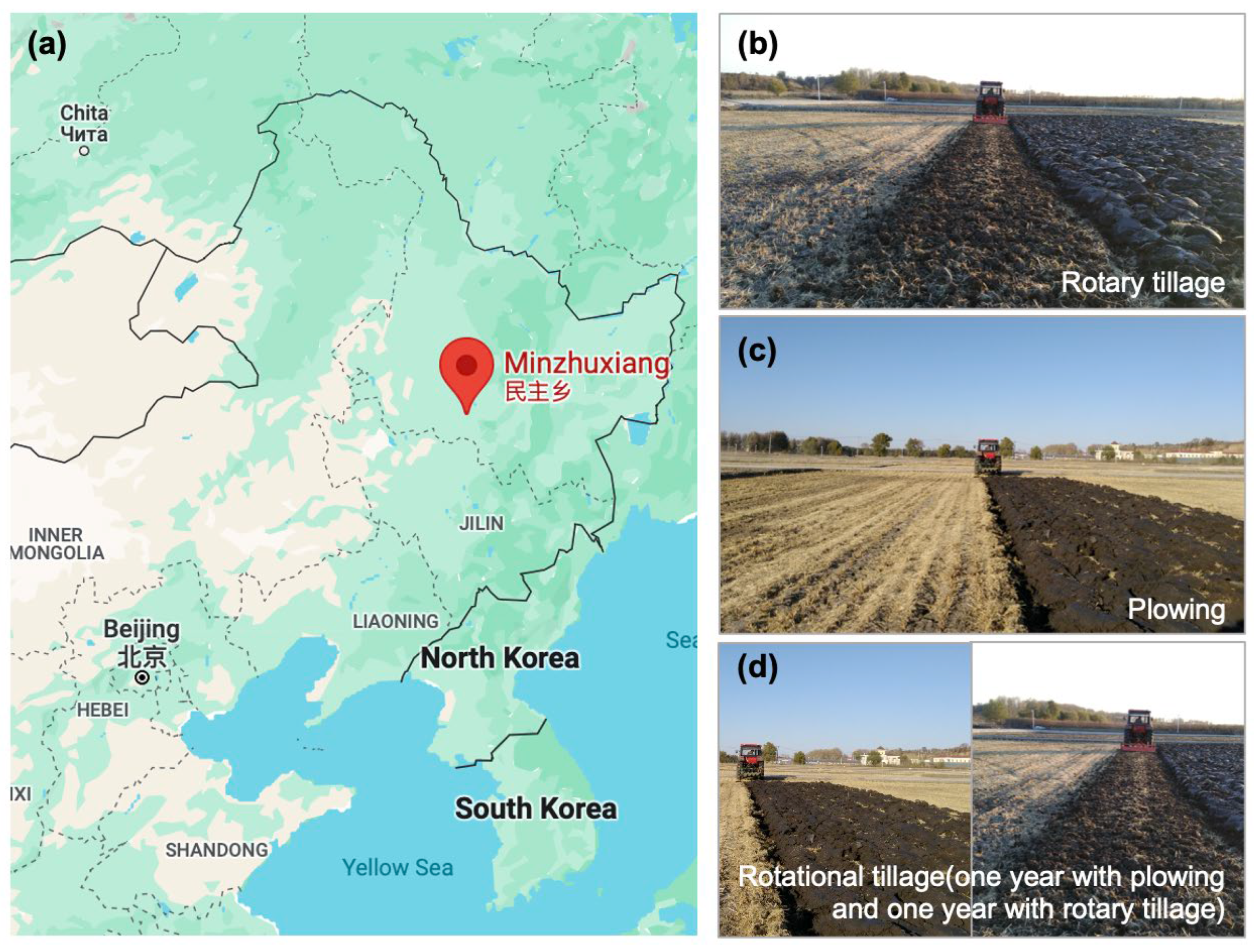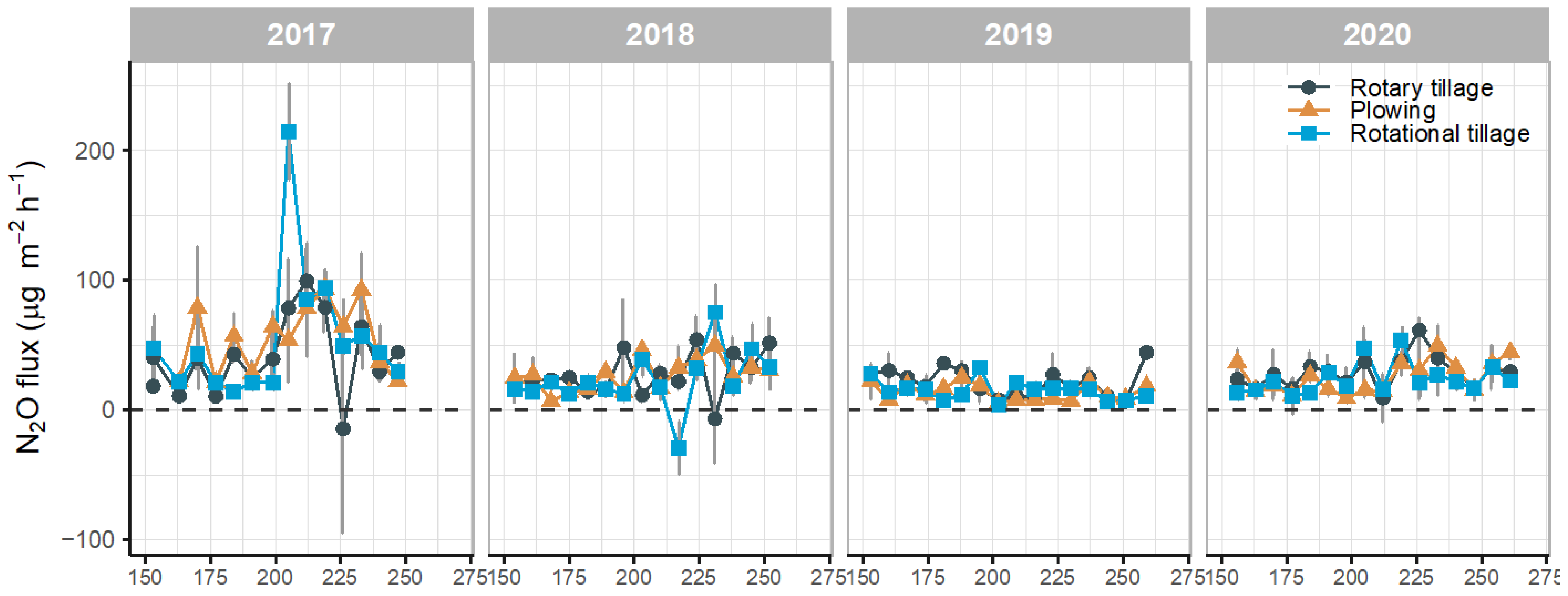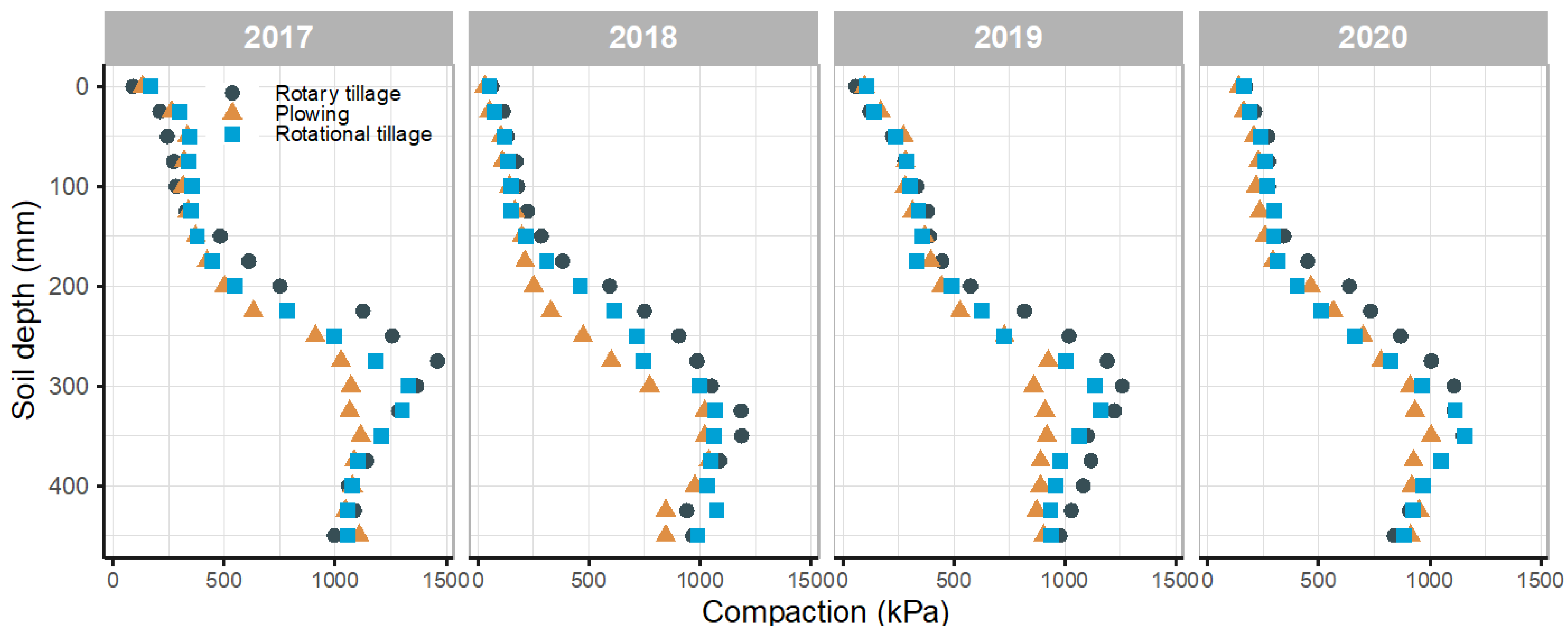Balancing Greenhouse Gas Emissions and Yield through Rotational Tillage in the Cold Rice-Growing Region
Abstract
1. Introduction
2. Materials and Methods
2.1. Description of Experimental Sites
2.2. Field Experiment Design
2.3. Gas Sampling and Flux Calculations
2.4. Measurement of Other Indicators
2.5. Statistical Analysis
3. Results
3.1. CH4 Emissions
3.2. N2O Emission
3.3. Rice yield and GHGI
3.4. Soil Penetration Resistance
4. Discussion
5. Conclusions
Author Contributions
Funding
Data Availability Statement
Conflicts of Interest
References
- Yang, Y.; Wu, J.; Zhao, S.; Mao, Y.; Zhang, J.; Pan, X.; He, F.; van der Ploeg, M. Impact of Long-Term Sub-Soiling Tillage on Soil Porosity and Soil Physical Properties in the Soil Profile. Land Degrad. Dev. 2021, 32, 2892–2905. [Google Scholar] [CrossRef]
- Karlen, D.L.; Cambardella, C.A.; Kovar, J.L.; Colvin, T.S. Soil Quality Response to Long-Term Tillage and Crop Rotation Practices. Soil Tillage Res. 2013, 133, 54–64. [Google Scholar] [CrossRef]
- Deike, S.; Pallutt, B.; Melander, B.; Strassemeyer, J.; Christen, O. Long-Term Productivity and Environmental Effects of Arable Farming as Affected by Crop Rotation, Soil Tillage Intensity and Strategy of Pesticide Use: A Case-Study of Two Long-Term Field Experiments in Germany and Denmark. Eur. J. Agron. 2008, 29, 191–199. [Google Scholar] [CrossRef]
- Roger-Estrade, J.; Anger, C.; Bertrand, M.; Richard, G. Tillage and Soil Ecology: Partners for Sustainable Agriculture. Soil Tillage Res. 2010, 111, 33–40. [Google Scholar] [CrossRef]
- Carter, M.R.; Sanderson, J.B.; Ivany, J.A.; White, R.P. Influence of Rotation and Tillage on Forage Maize Productivity, Weed Species, and Soil Quality of a Fine Sandy Loam in the Cool-Humid Climate of Atlantic Canada. Soil Tillage Res. 2002, 67, 85–98. [Google Scholar] [CrossRef]
- Zhang, L.; Wang, J.; Fu, G.; Zhao, Y. Rotary Tillage in Rotation with Plowing Tillage Improves Soil Properties and Crop Yield in a Wheat-Maize Cropping System. PLoS ONE 2018, 13, e0198193. [Google Scholar] [CrossRef] [PubMed]
- Latifmanesh, H.; Deng, A.; Nawaz, M.M.; Li, L.; Chen, Z.; Zheng, Y.; Wang, P.; Song, Z.; Zhang, J.; Zheng, C.; et al. Integrative Impacts of Rotational Tillage on Wheat Yield and Dry Matter Accumulation under Corn-Wheat Cropping System. Soil Tillage Res. 2018, 184, 100–108. [Google Scholar] [CrossRef]
- Wang, R.; Ma, L.; Lv, W.; Li, J. Rotational Tillage: A Sustainable Management Technique for Wheat Production in the Semiarid Loess Plateau. Agriculture 2022, 12, 1582. [Google Scholar] [CrossRef]
- Wang, S.; Wang, H.; Zhang, Y.; Wang, R.; Zhang, Y.; Xu, Z.; Jia, G.; Wang, X.; Li, J. The Influence of Rotational Tillage on Soil Water Storage, Water Use Efficiency and Maize Yield in Semi-Arid Areas under Varied Rainfall Conditions. Agric. Water Manag. 2018, 203, 376–384. [Google Scholar] [CrossRef]
- Zhang, Y.; Wang, S.; Wang, H.; Ning, F.; Zhang, Y.; Dong, Z.; Wen, P.; Wang, R.; Wang, X.; Li, J. The Effects of Rotating Conservation Tillage with Conventional Tillage on Soil Properties and Grain Yields in Winter Wheat-Spring Maize Rotations. Agric. For. Meteorol. 2018, 263, 107–117. [Google Scholar] [CrossRef]
- Chimsah, F.A.; Cai, L.; Wu, J.; Zhang, R. Outcomes of Long-Term Conservation Tillage Research in Northern China. Sustainability 2020, 12, 1062. [Google Scholar] [CrossRef]
- Liu, Q.; Kan, Z.; He, C.; Zhang, H. Effects of Strategic Tillage on Soil Physicochemical Properties and Grain Yield in the North China Plain. Agronomy 2020, 10, 1167. [Google Scholar] [CrossRef]
- Tian, P.; Lian, H.; Wang, Z.; Jiang, Y.; Li, C.; Sui, P.; Qi, H. Effects of Deep and Shallow Tillage with Straw Incorporation on Soil Organic Carbon, Total Nitrogen and Enzyme Activities in Northeast China. Sustainability 2020, 12, 8679. [Google Scholar] [CrossRef]
- Li, Y.; Li, Z.; Cui, S.; Jagadamma, S.; Zhang, Q. Residue Retention and Minimum Tillage Improve Physical Environment of the Soil in Croplands: A Global Meta-Analysis. Soil Tillage Res. 2019, 194, 104292. [Google Scholar] [CrossRef]
- Guenet, B.; Gabrielle, B.; Chenu, C.; Arrouays, D.; Balesdent, J.; Bernoux, M.; Bruni, E.; Caliman, J.P.; Cardinael, R.; Chen, S.; et al. Can N2O Emissions Offset the Benefits from Soil Organic Carbon Storage? Glob. Chang. Biol. 2020, 27, 237–256. [Google Scholar] [CrossRef] [PubMed]
- Zuber, S.M.; Villamil, M.B. Meta-Analysis Approach to Assess Effect of Tillage on Microbial Biomass and Enzyme Activities. Soil Biol. Biochem. 2016, 97, 176–187. [Google Scholar] [CrossRef]
- Qian, H.; Zhu, X.; Huang, S.; Linquist, B.; Kuzyakov, Y.; Wassmann, R.; Minamikawa, K.; Martinez-Eixarch, M.; Yan, X.; Zhou, F.; et al. Greenhouse Gas Emissions and Mitigation in Rice Agriculture. Nat. Rev. Earth Environ. 2023, 4, 716–732. [Google Scholar] [CrossRef]
- Liao, P.; Sun, Y.; Zhu, X.; Wang, H.; Wang, Y.; Chen, J.; Zhang, J.; Zeng, Y.; Zeng, Y.; Huang, S. Identifying Agronomic Practices with Higher Yield and Lower Global Warming Potential in Rice Paddies: A Global Meta-Analysis. Agric. Ecosyst. Environ. 2021, 322, 107663. [Google Scholar] [CrossRef]
- Shang, Q.; Cheng, C.; Wang, J.; Luo, K.; Zeng, Y.; Yang, X. Net Global Warming Potential, Greenhouse Gas Intensity and Carbon Footprint as Affected by Different Tillage Systems from Chinese Double-Cropping Paddy Fields. Soil Tillage Res. 2021, 209, 104947. [Google Scholar] [CrossRef]
- Qin, X.; Li, Y.; Wan, Y.; Liao, Y.; Fan, M.; Gao, Q.; Liu, S.; Ma, X. Effect of Tillage and Rice Residue Return on CH4 and N2O Emission from Double Rice Field. Trans. Chin. Soc. Agric. Eng. 2014, 30, 216–224. [Google Scholar]
- Chen, Z.; Zhang, H.; Xue, J.; Liu, S.; Chen, F. A Nine-Year Study on the Effects of Tillage on Net Annual Global Warming Potential in Double Rice-Cropping Systems in Southern China. Soil Tillage Res. 2021, 206, 104797. [Google Scholar] [CrossRef]
- Zhang, Z.S.; Chen, J.; Liu, T.Q.; Cao, C.G.; Li, C.F. Effects of Nitrogen Fertilizer Sources and Tillage Practices on Greenhouse Gas Emissions in Paddy Fields of Central China. Atmos. Environ. 2016, 144, 274–281. [Google Scholar] [CrossRef]
- Kim, S.Y.; Gutierrez, J.; Kim, P.J. Unexpected Stimulation of CH4 Emissions under Continuous No-Tillage System in Mono-Rice Paddy Soils during Cultivation. Geoderma 2016, 267, 34–40. [Google Scholar] [CrossRef]
- Bayer, C.; Costa, F.d.S.; Pedroso, G.M.; Zschornack, T.; Camargo, E.S.; de Lima, M.A.; Frigheto, R.T.S.; Gomes, J.; Marcolin, E.; Macedo, V.R.M. Yield-Scaled Greenhouse Gas Emissions from Flood Irrigated Rice under Long-Term Conventional Tillage and No-till Systems in a Humid Subtropical Climate. Field Crop. Res. 2014, 162, 60–69. [Google Scholar] [CrossRef]
- Pandey, D.; Agrawal, M.; Bohra, J.S. Greenhouse Gas Emissions from Rice Crop with Different Tillage Permutations in Rice-Wheat System. Agric. Ecosyst. Environ. 2012, 159, 133–144. [Google Scholar] [CrossRef]
- Fangueiro, D.; Becerra, D.; Albarrán, Á.; Peña, D.; Sanchez-Llerena, J.; Rato-Nunes, J.M.; López-Piñeiro, A. Effect of Tillage and Water Management on GHG Emissions from Mediterranean Rice Growing Ecosystems. Atmos. Environ. 2017, 150, 303–312. [Google Scholar] [CrossRef]
- Shakoor, A.; Shahbaz, M.; Farooq, T.H.; Sahar, N.E.; Shahzad, S.M.; Altaf, M.M.; Ashraf, M. A Global Meta-Analysis of Greenhouse Gases Emission and Crop Yield under No-Tillage as Compared to Conventional Tillage. Sci. Total Environ. 2021, 750, 142299. [Google Scholar] [CrossRef]
- Zhao, X.; Liu, S.L.; Pu, C.; Zhang, X.Q.; Xue, J.F.; Zhang, R.; Wang, Y.Q.; Lal, R.; Zhang, H.L.; Chen, F. Methane and Nitrous Oxide Emissions under No-till Farming in China: A Meta-Analysis. Glob. Chang. Biol. 2016, 22, 1372–1384. [Google Scholar] [CrossRef] [PubMed]
- Danso, F.; Bankole, O.O.; Zhang, N.; Dong, W.; Zhang, K.; Lu, C.; Shang, Z.; Li, G.; Deng, A.; Song, Z.; et al. Plough Tillage Maintains High Rice Yield and Lowers Greenhouse Gas Emissions under Straw Incorporation in Three Rice-Based Cropping Systems. Agronomy 2023, 13, 880. [Google Scholar] [CrossRef]
- Hou, X.; Li, R.; Jia, Z.; Han, Q. Research Progress on Ecological Effects under the Rotational Tillage Patternsin Agricultural Regions of China. Acta Ecol. Sin. 2016, 36, 1215–1223. [Google Scholar]
- NBSC (National Bureau of Statistics of China). China Statistical Yearbook (1981–2021); China Statistics Press: Beijing, China, 2021.
- Yang, J.; Gu, S.; Li, Y.; He, W.; Tang, Y.; Zhai, C.; Du, L. Effects of Deep Ploughing-Rotary Tillage Combined with Organic Fertilizer on Black Soil Physical Properties. Chin. J. Soil Sci. 2021, 52, 1290–1298. [Google Scholar] [CrossRef]
- He, W.; Gu, S.; Gu, S.; Che, Y.; Wang, Z.; Yuan, W.; Yang, J. Effects of Deep-till-Rototill Rotation and Organic Fertilizer Application on Enzyme Activity in Aggregates of Black Soil Cropland. Chinese J. Ecol. 2023, 42, 1090–1098. [Google Scholar]
- Hou, X.; Li, R.; Jia, Z.; Han, Q.; Wang, W.; Yang, B. Effects of Rotational Tillage Practices on Soil Properties, Winter Wheat Yields and Water-Use Efficiency in Semi-Arid Areas of North-West China. Field Crop. Res. 2012, 129, 7–13. [Google Scholar] [CrossRef]
- De Klein, C.A.M.; Harvey, M. (Eds.) Nitrous Oxide Chamber Methodology Guidelines; Ministry of Primary Industries: Wellington, New Zealand, 2012; ISBN 978-0-478-40584-2. [Google Scholar]
- Zou, J.; Huang, Y.; Jiang, J.; Zheng, X.; Sass, R.L. A 3-year Field Measurement of Methane and Nitrous Oxide Emissions from Rice Paddies in China: Effects of Water Regime, Crop Residue, and Fertilizer Application. Global Biogeochem. Cycles 2005, 19, 2. [Google Scholar] [CrossRef]
- Mosier, A.R.; Halvorson, A.D.; Reule, C.A.; Liu, X.J. Net Global Warming Potential and Greenhouse Gas Intensity in Irrigated Cropping Systems in Northeastern Colorado. J. Environ. Qual. 2006, 35, 1584–1598. [Google Scholar] [CrossRef] [PubMed]
- Meehl, G.A.; Stocker, T.F.; Collins, W.D.; Friedlingstein, P.; Gaye, T.; Gregory, J.M.; Kitoh, A.; Knutti, R.; Murphy, J.M.; Noda, A.; et al. Global Climate Projections. In IPCC, 2007: Climate Change 2007: The Physical Science Basis; Contribution of Working Group I to the Fourth Assessment Report of the Intergovernmental Panel on Climate Change; Solomon, S., Qin, D., Manning, M., Chen, Z., Marquis, M., Averyt, K.B., Tignor, M., Miller, H.L., Eds.; Cambridge University Press: Cambridge, UK, 2007; pp. 747–846. ISBN 0521880092. [Google Scholar]
- Ogle, S.M.; Wakelin, S.J.; Buendia, L.; McConkey, B.; Baldock, J.; Akiyama, H.; Kishimoto, A.W.M.; Chirinda, N.; Bernoux, M.; Bhattacharya, S.; et al. Cropland. In 2019 Refinement to the 2006 IPCC Guidelines for National Greenhouse Gas Inventories; Calvo Buendia, E., Tanabe, K., Kranjc, A., Baasansuren, J., Fukuda, M.S.N., Osako, A., Pyrozhenko, Y., Shermanau, P., Federici, S., Eds.; IPCC: Interlaken, Switzerland, 2019; pp. 1–102. [Google Scholar]
- Wang, J.; Akiyama, H.; Yagi, K.; Yan, X. Controlling Variables and Emission Factors of Methane from Global Rice Fields. Atmos. Chem. Phys. 2018, 18, 10419–10431. [Google Scholar] [CrossRef]
- Nikolaisen, M.; Cornulier, T.; Hillier, J.; Smith, P.; Albanito, F.; Nayak, D. Methane Emissions from Rice Paddies Globally: A Quantitative Statistical Review of Controlling Variables and Modelling of Emission Factors. J. Clean. Prod. 2023, 409, 137245. [Google Scholar] [CrossRef]
- National Development and Reform Commission of the People’s Republic of China. Guidelines for the Preparation of Provincial Greenhouse Gas Inventories; National Development and Reform Commission of the People’s Republic of China: Beijing, China, 2011. [Google Scholar]
- Zhang, Y.; Jiang, Y.; Tai, A.P.K.; Feng, J.; Li, Z.; Zhu, X.; Chen, J.; Zhang, J.; Song, Z.; Deng, A.; et al. Contribution of Rice Variety Renewal and Agronomic Innovations to Yield Improvement and Greenhouse Gas Mitigation in China. Environ. Res. Lett. 2019, 14, 114020. [Google Scholar] [CrossRef]
- Qin, X.; Li, Y.; Wang, H.; Li, J.; Wan, Y.; Gao, Q.; Liao, Y.; Fan, M. Effect of Rice Cultivars on Yield-Scaled Methane Emissions in a Double Rice Field in South China. J. Integr. Environ. Sci. 2015, 12, 47–66. [Google Scholar] [CrossRef]
- Zou, J.; Lu, Y.; Huang, Y. Estimates of Synthetic Fertilizer N-Induced Direct Nitrous Oxide Emission from Chinese Croplands during 1980–2000. Environ. Pollut. 2010, 158, 631–635. [Google Scholar] [CrossRef]
- Zou, J.; Huang, Y.; Qin, Y.; Liu, S.; Shen, Q.; Pan, G.; Lu, Y.; Liu, Q. Changes in Fertilizer-Induced Direct N2O Emissions from Paddy Fields during Rice-Growing Season in China between 1950s and 1990s. Glob. Chang. Biol. 2009, 15, 229–242. [Google Scholar] [CrossRef]
- Tang, Z.; Zhang, J.; Deng, A.; Zhang, W. Temporal-Spatial Characteristics and Reduction Approaches of Methane Emission from Rice Fields in China. Chin. J. Eco-Agric. 2021, 26, 582–591. [Google Scholar] [CrossRef]
- Li, Y. Effects of Different Tillage Methods on Soil Structure and CH4 and N2O Emissions in Paddy Field Rotated with Wheat Cropping under Straw Incorporation. Master’s Thesis, Nanjing Agricultural University, Najing, China, 2021. [Google Scholar]
- Zhang, Z.S.; Cao, C.G.; Guo, L.J.; Li, C.F. Emissions of CH4 and CO2 from Paddy Fields as Affected by Tillage Practices and Crop Residues in Central China. Paddy Water Environ. 2016, 14, 85–92. [Google Scholar] [CrossRef]
- Xue, J.F.; Pu, C.; Liu, S.L.; Chen, Z.; Chen, F.; Xiao, X.P.; Lal, R.; Zhang, H.L. Effects of Tillage Systems on Soil Organic Carbon and Total Nitrogen in a Double Paddy Cropping System in Southern China. Soil Tillage Res. 2015, 153, 161–168. [Google Scholar] [CrossRef]
- Bu, R.; Li, M.; Cheng, W.; Han, S.; Wang, H.; Tang, S.; Lu, C.; Wu, J. Subsoil Tillage and Organic Fertilization Benefit Rice Root Growth and Yield by Ameliorating Soil Compaction and Fertility. J. Soil Sci. Plant Nutr. 2023, 23, 6114–6124. [Google Scholar] [CrossRef]
- Han, B.; Li, Z.; Wang, Y.; Ning, T.; Zheng, Y.; Shi, Z. Effects of Soil Tillage and Returning Straw to Soil on Wheat Growth Status and Yield. Trans. Chinese Soc. Agric. Eng. 2007, 23, 48–53. [Google Scholar]




| Year | Treatment | CH4 (kg ha−1) | N2O (kg ha−1) | GWP (kg CO2-eq ha−1) | Yield (t ha−1) | GHGI (kg CO2-eq kg−1) |
|---|---|---|---|---|---|---|
| 2017 | Rotary tillage | 354.7 ± 30.1 a 1 | 1.31 ± 0.33 a | 9260 ± 820 a | 7.67 ± 0.59 a | 1.21 ± 0.14 a |
| Plowing | 317.8 ± 35.5 ab | 1.45 ± 0.25 a | 8379 ± 957 a | 8.00 ± 1.51 a | 0.93 ± 0.09 b | |
| Rotational tillage | 280.2 ± 5.7 b | 1.49 ± 0.20 a | 7450 ± 92 a | 8.50 ± 0.05 a | 0.88 ± 0.01 b | |
| 2018 | Rotary tillage | 314.5 ± 10.8 a | 0.81 ± 0.39 a | 8104 ± 88 a | 8.28 ± 0.06 a | 0.98 ± 0.01 a |
| Plowing | 267.8 ± 21.2 b | 0.79 ± 0.15 a | 6932 ± 420 b | 7.80 ± 0.81 a | 0.89 ± 0.05 b | |
| Rotational tillage | 270.9 ± 23.1 b | 0.68 ± 0.15 a | 6974 ± 419 b | 8.77 ± 0.12 a | 0.80 ± 0.05 c | |
| 2019 | Rotary tillage | 417.9 ± 106.7 a | 0.68 ± 0.12 a | 10,650 ± 2650 a | 9.35 ± 0.06 a | 1.14 ± 0.28 a |
| Plowing | 344.6 ± 9.9 ab | 0.44 ± 0.04 b | 8744 ± 258 ab | 9.57 ± 0.68 a | 0.91 ± 0.05 ab | |
| Rotational tillage | 227.4 ± 34.2 b | 0.48 ± 0.05 b | 5828 ± 866 b | 9.67 ± 0.49 a | 0.60 ± 0.09 b | |
| 2020 | Rotary tillage | 276.7 ± 17.2 a | 0.81 ± 0.20 a | 7159 ± 308 a | 9.53 ± 0.06 a | 0.75 ± 0.03 a |
| Plowing | 294.1 ± 22.1 a | 0.76 ± 0.15 a | 7577 ± 509 a | 10.12 ± 1.63 a | 0.76 ± 0.07 a | |
| Rotational tillage | 265.1 ± 16.9 a | 0.64 ± 0.07 a | 6819 ± 405 a | 10.19 ± 0.08 a | 0.67 ± 0.04 a |
Disclaimer/Publisher’s Note: The statements, opinions and data contained in all publications are solely those of the individual author(s) and contributor(s) and not of MDPI and/or the editor(s). MDPI and/or the editor(s) disclaim responsibility for any injury to people or property resulting from any ideas, methods, instructions or products referred to in the content. |
© 2024 by the authors. Licensee MDPI, Basel, Switzerland. This article is an open access article distributed under the terms and conditions of the Creative Commons Attribution (CC BY) license (https://creativecommons.org/licenses/by/4.0/).
Share and Cite
Dong, W.; Tang, A.; Zhang, J.; Liu, Y.; Meng, Y.; Zhang, X.; Wang, L.; Yang, Z. Balancing Greenhouse Gas Emissions and Yield through Rotational Tillage in the Cold Rice-Growing Region. Agronomy 2024, 14, 1476. https://doi.org/10.3390/agronomy14071476
Dong W, Tang A, Zhang J, Liu Y, Meng Y, Zhang X, Wang L, Yang Z. Balancing Greenhouse Gas Emissions and Yield through Rotational Tillage in the Cold Rice-Growing Region. Agronomy. 2024; 14(7):1476. https://doi.org/10.3390/agronomy14071476
Chicago/Turabian StyleDong, Wenjun, Ao Tang, Jun Zhang, Youhong Liu, Ying Meng, Xijuan Zhang, Lizhi Wang, and Zhongliang Yang. 2024. "Balancing Greenhouse Gas Emissions and Yield through Rotational Tillage in the Cold Rice-Growing Region" Agronomy 14, no. 7: 1476. https://doi.org/10.3390/agronomy14071476
APA StyleDong, W., Tang, A., Zhang, J., Liu, Y., Meng, Y., Zhang, X., Wang, L., & Yang, Z. (2024). Balancing Greenhouse Gas Emissions and Yield through Rotational Tillage in the Cold Rice-Growing Region. Agronomy, 14(7), 1476. https://doi.org/10.3390/agronomy14071476







